AMD Ryzen 9 5980HS Cezanne Review: Ryzen 5000 Mobile Tested
by Dr. Ian Cutress on January 26, 2021 9:00 AM EST- Posted in
- CPUs
- AMD
- Vega
- Ryzen
- Zen 3
- Renoir
- Notebook
- Ryzen 9 5980HS
- Ryzen 5000 Mobile
- Cezanne
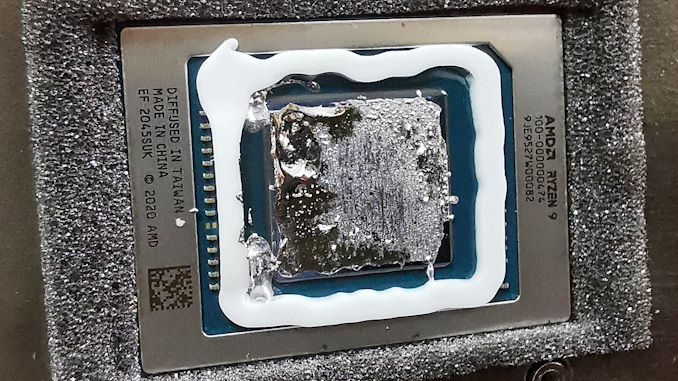
Since AMD’s introduction of its newest Zen 3 core for desktop users, the implementation for notebooks and mobile users has been eagerly awaited. In a single generation, on the same manufacturing process, AMD extracted +19% more performance per clock (we verified), so for any system that is power limited, extra performance is often very well received. AMD announced its new Ryzen 5000 Mobile processor family at the start of the year, with processors from 15W to 45W+ in the pipeline, and the first mobile systems coming to market in February. AMD sent us a peak example of Ryzen 5000 Mobile for today’s review, the 35W Ryzen 9 5980HS, as contained in the ASUS ROG Flow X13.
Ryzen 5000 Mobile: Eight Zen 3 cores and Vega 8 Graphics
For those that didn’t catch the original announcement a couple of weeks ago, here is a recap of the Ryzen 5000 Mobile family as well as the key points from the announcement.
The Ryzen 5000 Mobile processor series is an upgrade over last year’s Ryzen 4000 Mobile processor series. AMD co-designed both of these processor families to re-use key parts of the chip design, enabling a fast time-to-market and quicker upgrade cycle for AMD’s notebook manufacturing partners (OEMs), like Dell, HP, Lenovo, and others. The major difference between the two processors that most users will encounter is that the new hardware uses eight of AMD’s latest Zen 3 CPU cores, which is an upgrade over the eight Zen 2 cores from last year. The highlight is the +19% raw performance uplift when comparing the two at the same frequency.
Under the hood, there are a few more key changes that enthusiasts will be interested in. The new 8-core Zen 3 design shares a combined 16 MB L3 cache, which enables any of the eight cores to access the full cache, reducing latency to main memory (from 4 MB to 16 MB) compared to the previous design which had two clusters of four Zen 2 cores, each with 4 MB of cache.
The new processor is 180 mm2 in size, compared to 156 mm2 of last generation, but still fits into the same socket. It contains 10.7 billion transistors, which is up from 9.8 billion. This means an effective decrease in transistor density, although we know that Zen 3 cores are slightly larger than Zen 2 cores, and some additional security measures have been added (more on this on the next page).
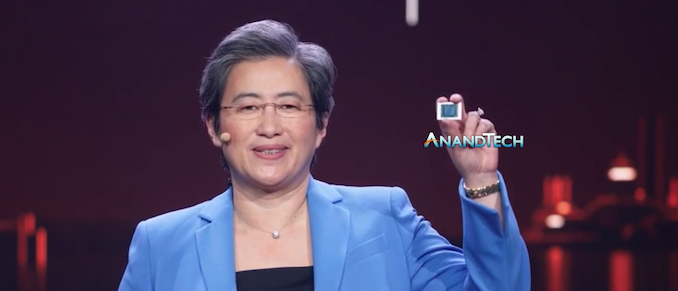
AMD CEO Dr. Lisa Su Showcasing Ryzen 5000 Mobile at CES
Users may be upset that the new processor range only features Vega 8 graphics, the same as last year’s design, however part of the silicon re-use comes in here enabling AMD to come to market in a timely manner. The Vega 8 design in the previous generation already had a big boost in efficiency and frequency, and this time around we get another +350 MHz on the high-end. Users who want to see RDNA in a mobile processor may have to wait longer. AMD’s re-use strategy may lend itself to changing CPU one generation, GPU the next – we will have to wait and see.
There are other SoC changes, which we will get to later in this review.
The Ryzen 5000 Mobile family is split into two broad product ranges, but both ranges use the same underlying silicon. At the top is the traditional 45 W H-series processors, aimed at productivity notebook designs. For this generation, AMD is pairing the traditional 45 W parts with a range of 35 W ‘HS’ models, optimized for more efficient designs – this will be AMD’s second generation of 35 W ‘HS’ class processors. AMD is also introducing a new range of ‘HX’ processors at 45 W and above which will allow AMD’s partners to co-design high-performance and/or overclockable AMD notebook solutions.
| AMD Ryzen 5000 Mobile: H-Series | |||||||
| AnandTech | Cores Threads |
Base Freq |
Boost Freq |
GPU Cores |
GPU Freq |
TDP | Zen |
| Ryzen 9 5980HX | 8C / 16T | 3300 | 4800 | 8 | 2100 | 45W+ | Zen3 |
| Ryzen 9 5980HS | 8C / 16T | 3000 | 4800 | 8 | 2100 | 35W | Zen3 |
| Ryzen 9 5900HX | 8C / 16T | 3300 | 4600 | 8 | 2100 | 45W+ | Zen3 |
| Ryzen 9 5900HS | 8C / 16T | 3000 | 4600 | 8 | 2100 | 35W | Zen3 |
| Ryzen 7 5800H | 8C / 16T | 3200 | 4400 | 8 | 2000 | 45W | Zen3 |
| Ryzen 7 5800HS | 8C / 16T | 2800 | 4400 | 8 | 2000 | 35W | Zen3 |
| Ryzen 5 5600H | 6C / 12T | 3300 | 4200 | 7 | 1800 | 45W | Zen3 |
| Ryzen 5 5600HS | 6C / 12T | 3000 | 4200 | 7 | 1800 | 35W | Zen3 |
When HS was introduced last year with Ryzen 4000 Mobile, it was an AMD-OEM partnership-only co-designed product requiring AMD approval in order to have access to them. This year however, they seem to be part of the full stack, indicating perhaps that demand for these HS designs was higher than expected.
The new HX models are here to enable high-end gaming, workstation, and desktop-replacement systems, as well as enabling vendors to supply overclockable laptops into the market with sufficient cooling provided. Overclockable laptops isn’t a new concept (Intel has been doing it a while), but it seems that AMD’s partners have requested higher power parts in order to enable this market on AMD. The official TDP for these processors is 45+ W, showcasing that partners can adjust the sustained TDP values north of 45 W if required, likely up to 65 W as needed. In the past, if OEMs wanted to go down this route, they would need to build a portable chassis capable of supporting a desktop processor.
There is some slight deviation from the regular H-series, in that there is no Ryzen 9 standard ‘H’ processor. The Ryzen 7 5800H will sit at the top of that particular market, but the way these numbering systems work means that the Ryzen 7 still has the full eight cores and fast integrated graphics. In that instance, Ryzen 9, with only HS and HX models, are arguably for more ‘specialist’ focused designs.
AMD is advertising the Ryzen 9 5980HS as the best processor for portable gaming performance, while the Ryzen 9 5980HX is ‘the best mobile processor for gaming’. As part of the launch day materials, AMD showcases the Ryzen 9 5980HS as scoring 600 pts in Cinebench R20, which would put it at the same level of performance as AMD’s desktop-class Zen 3 processors. We didn’t quite score 600 in this review with the R9 5980HS (we scored 578).
The traditional 15 W processors, used for ultra-thin and light portable notebooks, form part of the Ryzen 5000 Mobile U-series. AMD is enabling a number of parts with updated Zen 3 cores, but also introducing several processors based on the older Zen 2 design, albeit with updates.
| AMD Ryzen 5000 Mobile: U-Series | |||||||
| AnandTech | Cores Threads |
Base Freq |
Boost Freq |
GPU Cores |
GPU Freq |
TDP | Zen |
| Zen3 | |||||||
| Ryzen 7 5800U | 8C / 16T | 1900 | 4400 | 8 | 2000 | 15W | Zen3 |
| Ryzen 5 5600U | 6C / 12T | 2300 | 4200 | 7 | 1800 | 15W | Zen3 |
| Ryzen 3 5400U | 4C / 8T | 2600 | 4000 | 6 | 1600 | 15W | Zen3 |
| Zen2 | |||||||
| Ryzen 7 5700U | 8C / 16T | 1800 | 4300 | 8 | 1900 | 15W | Zen2 |
| Ryzen 5 5500U | 6C / 12T | 2100 | 4000 | 7 | 1800 | 15W | Zen2 |
| Ryzen 3 5300U | 4C / 8T | 2600 | 3800 | 6 | 1500 | 15W | Zen2 |
The simple way to identify this is with the digit after the number 5. Even digits (5800, 5600, 5400) are based on Zen 3, whereas odd digits (5700, 5500, 5300) are the updated versions of Zen 2. A lot of users will consider these latter processors identical to the previous generation, however we have learned that there are a number of key differences which we will cover in a separate article.
Nonetheless, AMD is promoting the top Ryzen 7 5800U as the company’s most efficient mobile processor to date. Based on a number of enhancements to the silicon design, AMD is claiming a +2hr battery life from a simple processor swap from Ryzen 4000 to Ryzen 5000, even if everything else in the chassis is the same. Nonetheless, AMD is stating that it has worked with controller companies, power delivery suppliers, and notebook designers in order to ensure that those OEMs that want to build systems with more than 20+ hours battery life have the tools to do so. Other OEMs however, particularly for low cost designs or perhaps education models, can freely change the processor from old to new with only a firmware update, as both Ryzen 4000 and Ryzen 5000 are pin compatible.
Overall AMD is claiming 150+ designs with Ryzen 5000 Mobile so far, a significant step up from the 100 designs on Ryzen 4000 Mobile. These are set to include high-end gaming designs with the latest premium graphics cards, a market that AMD has had difficulty breaking into so far.
| AMD Generation Code Names | ||||
| AnandTech | Brand | Core | Graphics | Process Node |
| Mobile Processors | ||||
| Cezanne | Ryzen 5000 Mobile | 8 x Zen 3 | Vega 8 | TSMC N7 |
| Lucienne | Ryzen 5000 Mobile | 8 x Zen 2 | Vega 8 | TSMC N7 |
| Renoir | Ryzen 4000 Mobile | 8 x Zen 2 | Vega 8 | TSMC N7 |
| Picasso | Ryzen 3000 Mobile | 4 x Zen+ | Vega 11 | GF 12nm |
| Raven Ridge | Ryzen 2000 Mobile | 4 x Zen | Vega 11 | GF 14nm |
| Dali | Athlon 3000 | 2 x Zen | Vega 3 | GF 14nm |
| Pollock | ? | 2 x Zen | Vega 3 | GF 14nm |
| Desktop Processors | ||||
| Vermeer | Ryzen 5000 | 16 x Zen 3 | - | TSMC N7 |
| Matisse | Ryzen 3000 | 16 x Zen 2 | - | TSMC N7 |
| Pinnacle Ridge | Ryzen 2000 | 8 x Zen+ | - | GF 12nm |
| Summit Ridge | Ryzen 1000 | 8 x Zen | - | GF 14nm |
| HEDT Processors | ||||
| Genesis Peak | '4th Gen' | Zen 3 | - | ? |
| Castle Peak | Threadripper 3000 | 64 x Zen 2 | - | TSMC N7 |
| Colfax | Threadripper 2000 | 32 x Zen+ | - | GF 12nm |
| Whitehaven | Threadripper 1000 | 16 x Zen | - | GF 14nm |
| Server Processors | ||||
| Genoa | '4th Gen' | Zen 4 | - | ? |
| Milan | EPYC 7003 | 64 x Zen 3 | - | TSMC N7 |
| Rome | EPYC 7002 | 64 x Zen 2 | - | TSMC N7 |
| Naples | EPYC 7001 | 32 x Zen | - | GF 14nm |
Here is a handy table of processor codenames we might use at various parts of these review. These refer to AMD’s internal codenames for the silicon designs, and act as an easier way to talk about the hardware without constantly referring to the branding (especially if certain silicon is used in multiple product ranges).
Testing AMD’s Claims: The Notebook
For this review, AMD supplied the Ryzen 9 5980HS inside the ASUS ROG Flow X13 laptop. It is one of AMD’s key design wins, with a 35 W-grade processor in a sleek design aimed for mobility. As a reviewer who in a normal year spends a lot of time travelling, the specifications on the box make a lot of sense to my regular workflow.
The system features a 13.4-inch 360º hinged display, which as an IPS touchscreen with a 3840x2400 resolution (16:10, finally) running at 120 Hz with adaptive sync, Pantone color certified, and coated in Corning Gorilla Glass. The display is rated for 116% sRGB, 86% Adobe, and 85% DCI-P3.
Under the hood is that AMD Ryzen 9 5980HS processor, with eight Zen 3 cores and sixteen threads, with a 3.0 GHz base frequency and a 4.8 GHz single core turbo frequency, rated at 35 W. ASUS says that they buy the best versions of the 5980HS for the Flow X13 to ensure the best performance and battery life. This processor has Vega 8 graphics, however ASUS has paired it with a GTX 1650 4 GB discrete graphics processor, enabling CUDA acceleration as well as higher performance gaming when needed.
Our unit comes with 32 GB of LPDDR4X-4267 memory, as well as a Western Digital SN350 1TB PCIe 3.0 x4 NVMe storage drive. Both of these would appear to be the standard install for the Flow X13.
ASUS claims the 62 Wh battery is good for 18 hours of use, and the Flow X13 is one of a handful of devices that supports 100 W USB Type-C power delivery. ASUS claims the bundled charger can charge the unit from 0% to 60% in around 39 minutes.
Other features include a back-lit keyboard with consistently sized arrow keys, a full-sized HDMI output as well as a USB 3.2 Gen 2 (10 Gbps) Type-A port, a USB 3.2 Gen 2 (10 Gbps) Type-C ports, a 3.5 mm jack, and a custom PCIe 3.0 x8 output connector for use with ASUS’ XG Mobile external graphics dock. This custom graphics dock can come with a custom designed RTX 3070/3080, and along with graphics power also provides the system with four more USB Type-A ports, HDMI/DP outputs, and Ethernet. With this dock installed, technically the system would have three graphics cards.
All of this comes in at 2.87 lbs / 1.30 Kg, all for under 16mm thick. This is often a key category for both AMD and Intel when it comes to mobility combined with productivity. ASUS has not announced pricing of the ROG Flow X13 yet – the other model in the range is based on the Ryzen 9 5900 HS, but is otherwise identical.
This review is going to be mostly about the processor rather than the Flow X13, due to time constraints (our sample arrived only a few days ago). However, it is worth noting that as with most notebooks, the ROG Flow X13 comes with multiple power and performance modes.
In fact, there are two: Silent and Performance. In each mode there are different values for idle temperature, in order to keep the any audible noise lower, and then different values for power/thermals for turbo and sustained power draw.
These two differ primarily in the sustained power draw and thermal limits:
| ASUS ROG Flow X13 Power Options | ||||||
| AnandTech | Idle Temp* |
Power Instant |
Turbo Power |
Turbo Temp |
Turbo Time |
Sustained |
| Silent | 70ºC | 65 W | 42 W | 85ºC | 6 sec | 15 W @ 68ºC |
| Performance | 65ºC | 65 W | 42 W | 85ºC | 120 sec | 35 W @ 75ºC |
*The idle temperature here is so high, as you'll see later in the review, because AMD's high-frequency levers are very aggressive such that our sensor monitoring tools are activating high frequency modes, despite the small load.
Testing AMD’s Claims: The Ryzen 9 5980HS
Similar to the launch of Ryzen 4000 Mobile, the unit AMD has supplied us is their top of the line but most efficient H-series processor. For the last generation it was the Ryzen 9 4900HS found in the ASUS ROG Zephyrus G14. The Zephyrus G14 is slightly bigger than the ROG Flow X14 we have today, but the GPU is also better on the G14 (2060 vs 1650). Both processors are rated at 35 W, and both showcase some of the best design AMD wants to lead with at the start of a generation.
The main competition for these processors is Intel’s Tiger Lake. A couple of weeks ago Intel announced its new line of H35 processors, whereby they boost the 15 W U-series processors up to 35 W for additional performance. We have no word on when those units will be in the market (we are told soon), however we have managed to secure an MSI Prestige 14 Evo which contains Intel’s best U-series processor (Core i7-1185G7) and allows for sustained performance at 35 W.
| Comparison Points | ||||
| AnandTech | AMD R9 5980HS |
AMD R9 4900HS |
Intel Core i7-1185G7 |
Intel Core i7-1185G7 |
| Device | ASUS ROG Flow X13 | ASUS ROG Zephyrus G14 | Intel Reference Design | MSI Presige 14 Evo |
| CPU | R9 5980HS | R9 4900HS | i7-1185G7 | i7-1185G7 |
| DRAM | 32 GB LPDDR4-4267 |
16 GB DDR4-3200 |
16 GB LPDDR4-4267 |
16 GB LPDDR4-4267 |
| IGP | Vega 8 | Vega 8 | Iris Xe 64 | Iris Xe 64 |
| dGPU | GTX 1650 | RTX 2060 | - | - |
| Storage | WD SN350 1TB PCIe 3.0 x4 |
Intel 660p 1TB PCIe 3.0 x4 |
Samsung 1TB PCIe 3.0 x4 |
Phison E16 512 GB PCIe 3.0 x4 |
Alongside these numbers we also have historical data from Intel’s Tiger Lake reference platform which ran in 15 W and 28 W modes.
But first, let us discuss the new features in Ryzen 5000 Mobile.


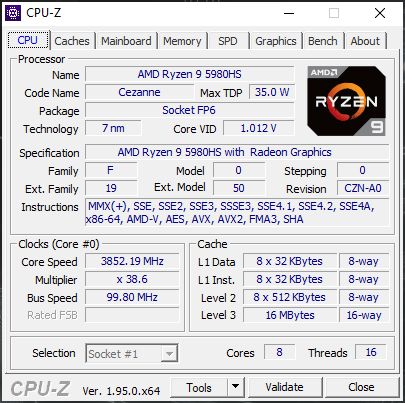
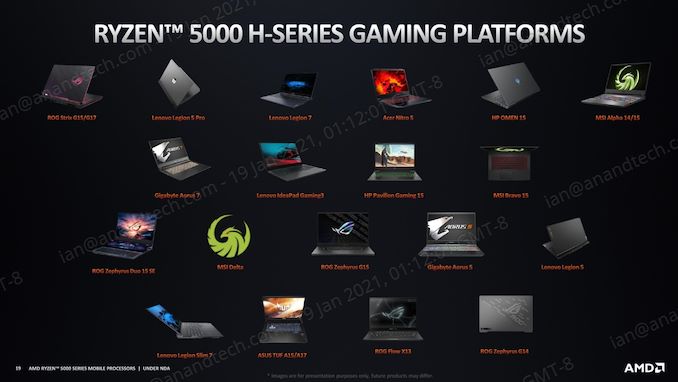
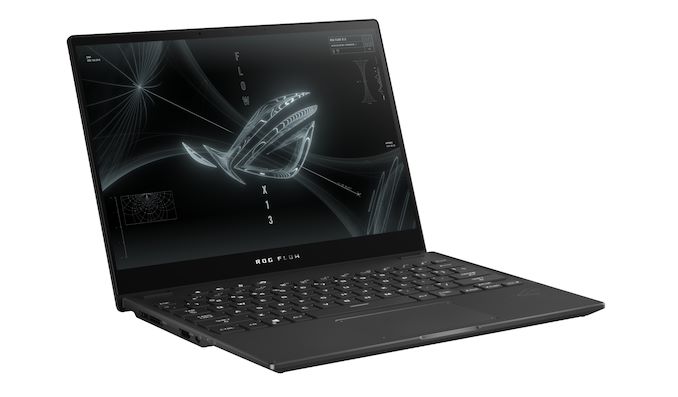
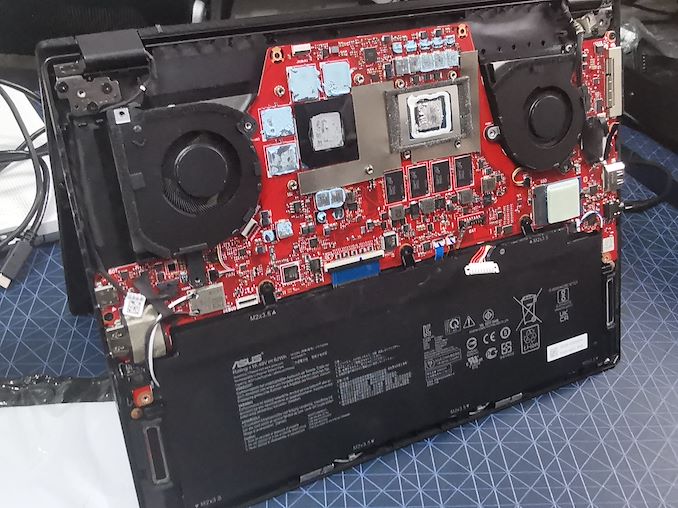
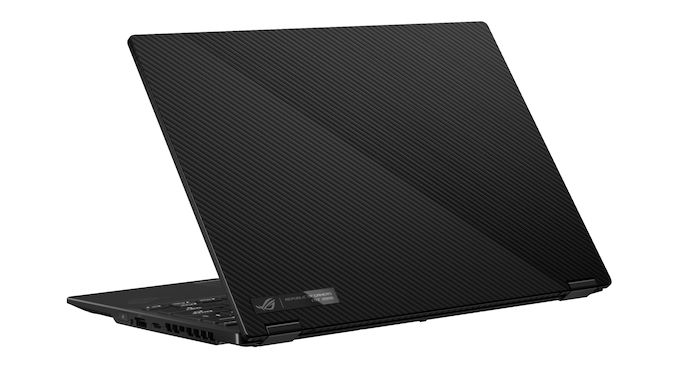
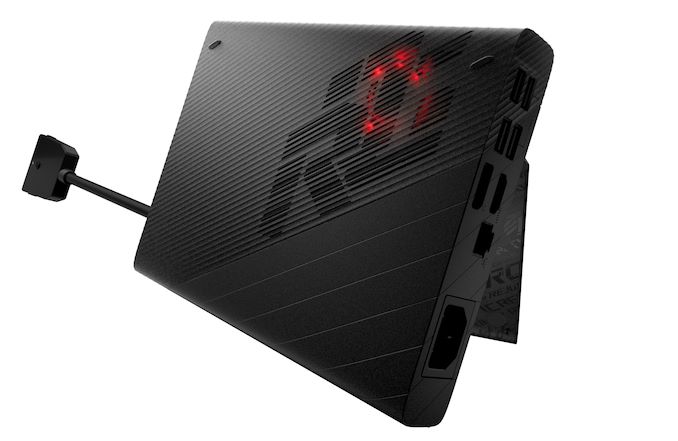








218 Comments
View All Comments
Tams80 - Monday, February 1, 2021 - link
Yes.Max_Nexor - Tuesday, February 2, 2021 - link
Do you use the Handbrake presets unmodified? If so, have you considered turning off the de-interlacing filter?Filters can slow down transcoding speed dramatically. For example, using the same video and the 480p Discord preset, my system (i7-4790K) transcodes the video at 136 fps. Turning off the interlace detection and the filter results in a speed of 221 fps. Enabling the Denoise filter reduces transcode speed from 221 fps to 15 fps.
Would it not be a better to test just the transcoding speed, without any filters?
Farfolomew - Thursday, February 4, 2021 - link
I'd like to point out that this new Asus Flow X13 laptop is quite unique, and kinda/sorta the first of it's kind of any device out there. How do I mean?Well, up to now, it's been all but impossible to buy a 360-degree hinged TOUCHSCREEN device, that also has a 120hz refresh panel. The only other laptop that had this were ones from HP that had a first-generation Privacy Screen built-in. The privacy screen has a feature that you can turn on and off to enable the viewing angles to be severely limited when desired. The first-gen versions of these had a knock-on effect of running at 120hz, so the touchscreen, 360-degree foldable versions of those are the only other touchscreen laptops with high refresh panels. None of them had particularly great gaming performance, as the best one available was a 4-core Kaby Lake-R powered Ultrabook. The new versions of HP's Privacy Screen no longer run at 120hz, so it was a limited time option.
That's why I'm so excited about this ASUS laptop. I wish it didn't have an external GPU, and only relied on the iGPU instead. But this is as close to my perfect device that has yet been created.
Tams80 - Thursday, February 4, 2021 - link
You do realise that the external GPU dock is optional right? And that *all* models have an Nvidia GTX 1650 in the laptop itself?Farfolomew - Thursday, February 4, 2021 - link
AMD says it had "100 design wins" for Renoir, and 50% more, "150 design wins" for Cezanne. Whatever a "Design Win" means, for that matter.All I know is that when I go into Best Buy to peruse the laptops section, I consistently see two things:
1. While a substantially bigger section, with at least 10x as many different products on display, the "Windows" section is nearly always barren of customers, while the Apple section is most certainly dangerously close to violating every COVID Best Practices known to science.
2. Last I counted, there were about 20-30 Intel Tiger Lake "EVO" branded laptops from all the major OEMs, while I saw less than five, yes FIVE IN TOTAL Ryzen laptops even available for sale. And most of those Ryzen laptops were of the gaming variety. I don't recall seeing a single Ryzen Ultrabook (ie, with just a iGPU).
So I want to know, what is AMD's plans exactly for changing this? They may have an overall better product (albeit at times, only narrowly) than Intel's Tiger Lake, if they can't ship these and get them out in front of the normal Joe customer who doesn't follow the tech scene, they'll never gain significant market share from Intel in the Laptop segment.
GeoffreyA - Sunday, February 7, 2021 - link
I wonder how much of this is due to public perception. Enthusiasts know that AMD is good but most people don't know or care, while some have a vague instinct telling them Intel is first-rate and AMD substandard (corroborated by advice of salespeople in the shop). The laptop seems proper if it's got an Intel sticker, otherwise no good. And that's something which will be very hard for AMD to change. Perhaps fewer Ryzen gaming laptops will help. Even a new logo/sticker for their mobile CPUs, with minimal elegant design.GeoffreyA - Sunday, February 7, 2021 - link
Also, they need to capture the general public's imagination, as silly as that sounds. Just like Samsung did. There was a time when people didn't think much of Samsung (in my country at any rate) but nowadays go into the shop and they've got the best fridges, TVs, and washing machines. Or that's the perception.Farfolomew - Thursday, February 4, 2021 - link
I'm a bit disappointed and left scratching my head regarding the GPU review section of this article. 360p, 480p resolutions ... what are we playing MS-DOS games in EGA 256-color mode?!How did those games even run at such low resolutions? That's mind boggling.
At any rate, it all led to a confusing non-conclusion of what exactly the iGPU performance is on these Cezanne chips, and how it compares to Tiger Lake. Is it better than Tiger Lake or not? How much better than Renoir is it?
I realize this isn't all Ian's fault, as the laptop given to him has a 35W CPU, and we're asking him to compare it to 15W Ultrabooks, etc. But it was still very confusing to me. Hopefully it will become more clear when (and if) AMD Cezanne Ultrabooks come out with 15W parts.